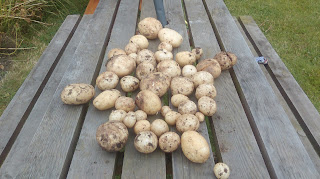Mushrooms and Poly Tunnel
Earlier on in the year I tried growing mushrooms.
Previous posts:
I didn't think that the temperature was right and gave up on them but over the last couple of days they have appeared. I say they but more correctly "it" appeared.
One mushroom has grown:
It shows that it worked but hasn't exactly been a great success. I think I'll put the idea of growing mushrooms outdoors to the back of my mind for now :)
The poly tunnel on the other hand is going great. Everything is growing strongly even to the point where a harvest can now be taken from the salad leaves. The Spring Onions have germinated as well as the radish. The garlic, although not showing yet has grown some roots and is about to poke through the soil and the field beans sown in a corner to see if they will fruit earlier than outdoors have started to grow.
(Click to enlarge pictures)
On the left the Oak leaf lettuce and Mizuna are going very well as is the beetroot, on the right the Chard and Pak Choi are also growing very strongly.
In the middle the Spinach, Radish, Garlic, Spring Onion, Strawberry and Chinese Cabbage are doing just as well.
What is immediately noticeable is that none of the leaves have been nibbled so everything is looking perfect. The Cape Gooseberry has even flowered. It's only been a few weeks since we put the Poly Tunnel in (see: Poly Tunnel Post) but the extra warmth and humidity has made a big difference as has the fact that it hasn't needed watering much since the humidity and lack of a drying wind has kept the soil moist. The roof of the Tunnel collects water droplets and automatically waters the beds as well, which is a nice bonus.
Today has been a rather breezy day but the Tunnel's plastic isn't noticing the wind much which bodes well for the much windier days ahead. This week the max temp reached 30 deg C and the minimum went down to 1.2 deg C so no frosty conditions inside the tunnel even though a few people have commented that they have had a ground frost in the area. It is now noticeable that the day time sun is not effective enough to warm the soil to keep the night time temp higher than the outside by the end of the night and I think that after a few hours of darkness any residual heat has dissipated by midnight.
My next job, and probably tonight, will be to put a heater inside set to the anti-frost setting, on for 2 hours from midnight to see if that will keep the inside temp a degree or two above the outside temp. The tunnel is probably too big for the heater to raise the temperature enough so that it can turn off the heat. If it fails to heat up quickly and be able to turn off then it will be a waste of time as the cost of the electricity will be a waste of energy but it's worth a test. A 2 kW heater on for 2 hours is going to cost 26p a night but if it can manage to do it's job and only be on for 45 minutes then at under 10p a night it might just extend the growing season for a few more weeks before the proper cold weather sets in. Once the proper cold spell starts the idea of a heater becomes silly, price and energy wastage wise but if the plants can just be allowed to grow for another 2 weeks then the amount of salad leaves we get and can sell will make it worth while. The same will apply at the end of the winter. If we can get the temperature up by just a degree or 2 during the night late February and the day time sun starts to heat the tunnel then we might get a months head start on some crops for next year. If we can sell the leaves (as we currently do) a couple of weeks later and a few weeks earlier than the other Alford Country Market growers then we'll have one month per year being the only one selling these products and therefore no competition.
One of the problems with selling home grown produce is that when winter starts the customers will be forced back into the super markets to buy their greens for juicing. By postponing that by a few weeks you can keep them loyal for longer and they can keep their habit of buying from us. By starting to sell the greens earlier in the new year using a poly tunnel we will have more time to pull them back in and get them back in the habit of buying locally again before the main season starts.I can see the possibility that once the regular customers go back to the supermarket over winter they may not start to come back to the country market by the time we start selling again but if we have some of what they want before the start of the main season we can start to grab them back one by one slowly so they are already on the look out and thinking about the country market when our main produce starts coming through. Instead of being a slow start to the main season we may be able to get up to full speed selling quicker....anyway, if we don't try we'll never find the thing that works for us :)
Still hoping that the money and time spent on the poly tunnel will pay big dividends.

















































